Organizational Change and Effectiveness: McDonald's Field Study Report
VerifiedAdded on 2022/10/04
|8
|1716
|21
Report
AI Summary
This report provides an in-depth analysis of organizational change and effectiveness at McDonald's. It begins with a brief overview of the company's history and market position, followed by a detailed examination of various internal and external organizational stress fractures, including employee issues, product concerns, internal management failures, health concerns, technological challenges, human resource shortcomings, and supply chain vulnerabilities. The report identifies how these fractures could potentially lead to organizational failure. To address these challenges, the report proposes a comprehensive change management plan based on John Kotter's 8-step strategy, including creating a sense of urgency, building a guiding coalition, forming a strategic vision, communicating the vision, empowering others, generating short-term wins, not letting up, and creating a new culture. The report concludes by emphasizing the importance of proactive management to ensure McDonald's continued success, and it references several scholarly sources to support its findings and recommendations.
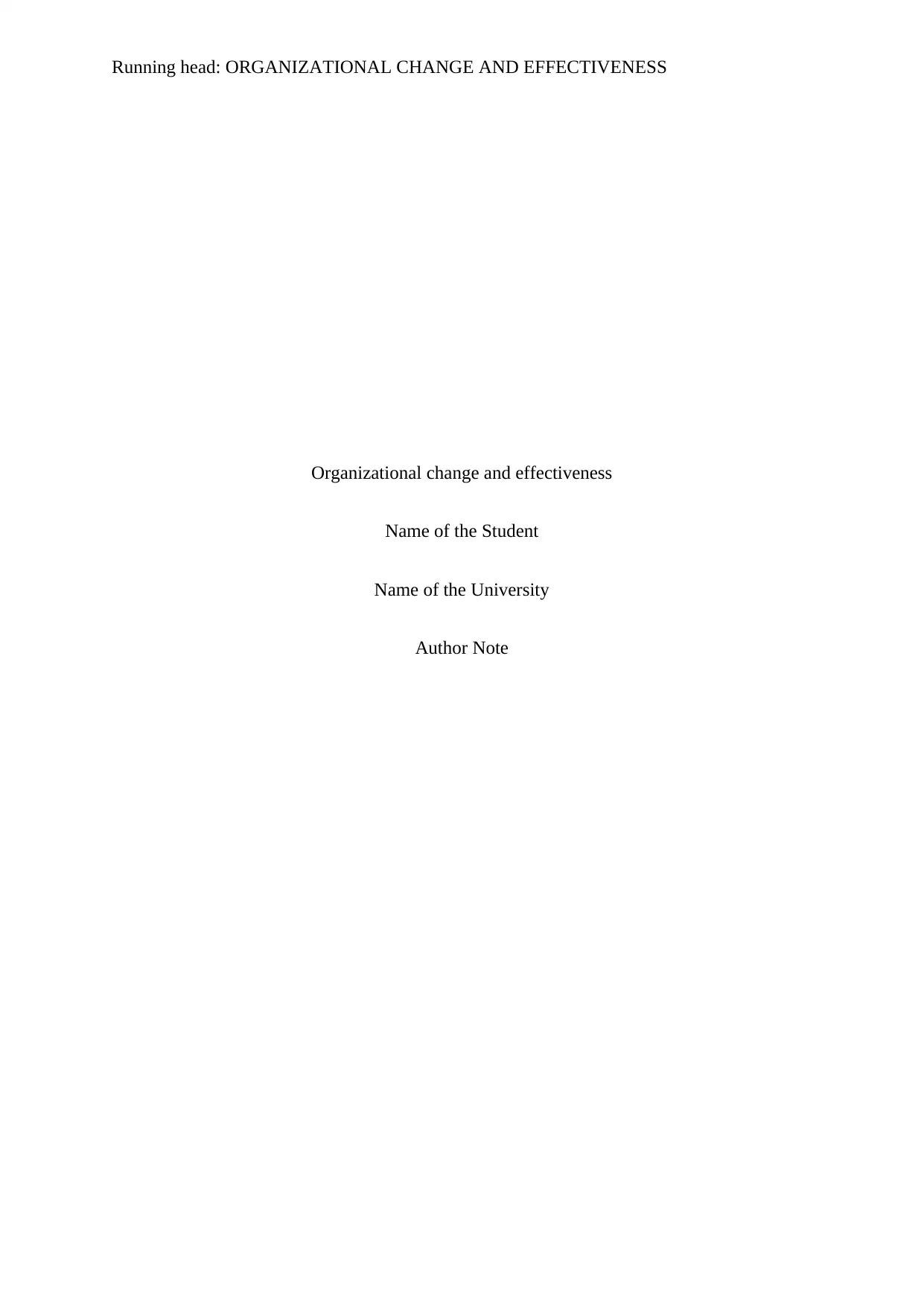
Running head: ORGANIZATIONAL CHANGE AND EFFECTIVENESS
Organizational change and effectiveness
Name of the Student
Name of the University
Author Note
Organizational change and effectiveness
Name of the Student
Name of the University
Author Note
Paraphrase This Document
Need a fresh take? Get an instant paraphrase of this document with our AI Paraphraser
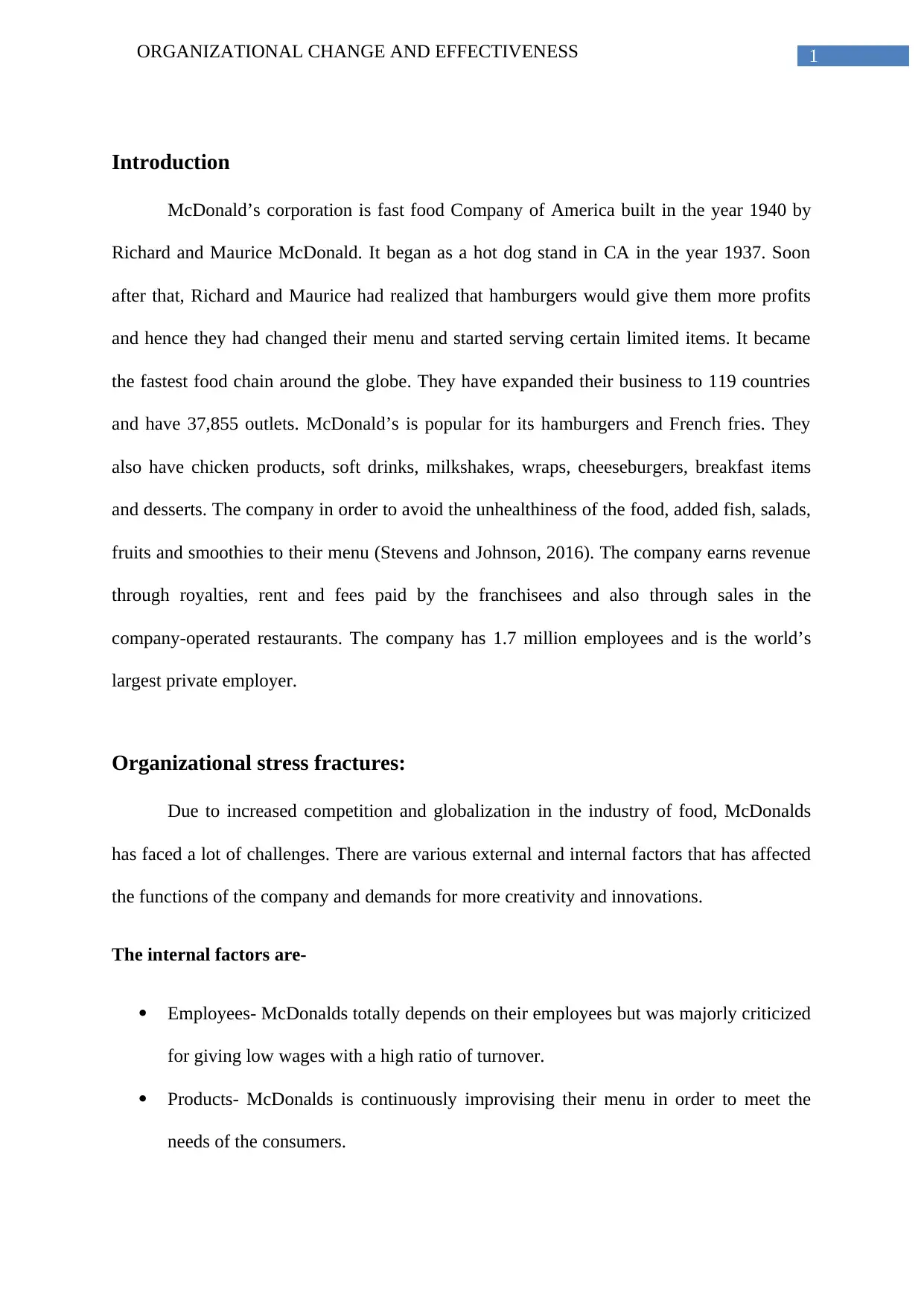
1ORGANIZATIONAL CHANGE AND EFFECTIVENESS
Introduction
McDonald’s corporation is fast food Company of America built in the year 1940 by
Richard and Maurice McDonald. It began as a hot dog stand in CA in the year 1937. Soon
after that, Richard and Maurice had realized that hamburgers would give them more profits
and hence they had changed their menu and started serving certain limited items. It became
the fastest food chain around the globe. They have expanded their business to 119 countries
and have 37,855 outlets. McDonald’s is popular for its hamburgers and French fries. They
also have chicken products, soft drinks, milkshakes, wraps, cheeseburgers, breakfast items
and desserts. The company in order to avoid the unhealthiness of the food, added fish, salads,
fruits and smoothies to their menu (Stevens and Johnson, 2016). The company earns revenue
through royalties, rent and fees paid by the franchisees and also through sales in the
company-operated restaurants. The company has 1.7 million employees and is the world’s
largest private employer.
Organizational stress fractures:
Due to increased competition and globalization in the industry of food, McDonalds
has faced a lot of challenges. There are various external and internal factors that has affected
the functions of the company and demands for more creativity and innovations.
The internal factors are-
Employees- McDonalds totally depends on their employees but was majorly criticized
for giving low wages with a high ratio of turnover.
Products- McDonalds is continuously improvising their menu in order to meet the
needs of the consumers.
Introduction
McDonald’s corporation is fast food Company of America built in the year 1940 by
Richard and Maurice McDonald. It began as a hot dog stand in CA in the year 1937. Soon
after that, Richard and Maurice had realized that hamburgers would give them more profits
and hence they had changed their menu and started serving certain limited items. It became
the fastest food chain around the globe. They have expanded their business to 119 countries
and have 37,855 outlets. McDonald’s is popular for its hamburgers and French fries. They
also have chicken products, soft drinks, milkshakes, wraps, cheeseburgers, breakfast items
and desserts. The company in order to avoid the unhealthiness of the food, added fish, salads,
fruits and smoothies to their menu (Stevens and Johnson, 2016). The company earns revenue
through royalties, rent and fees paid by the franchisees and also through sales in the
company-operated restaurants. The company has 1.7 million employees and is the world’s
largest private employer.
Organizational stress fractures:
Due to increased competition and globalization in the industry of food, McDonalds
has faced a lot of challenges. There are various external and internal factors that has affected
the functions of the company and demands for more creativity and innovations.
The internal factors are-
Employees- McDonalds totally depends on their employees but was majorly criticized
for giving low wages with a high ratio of turnover.
Products- McDonalds is continuously improvising their menu in order to meet the
needs of the consumers.

2ORGANIZATIONAL CHANGE AND EFFECTIVENESS
Internal management: The internal management plays an essential role in the
organization’s progress. The internal management of McDonalds fails in coordinating
with each other.
The external factors are:
Health concerns: it has been seen over the recent past that the food of McDonalds
has high health risks. This has created a negative impact on the customers about
the company. The food of McDonalds has serious damaging affects to the health
of the customers. The main reason being the low nutritional value of the meals,
which contain sodium, calories and high fat. The food contains significant amount
of grease and oil, which in turn is quite harmful as it, disposes huge amount of bad
fats into the body.
Technological stress fractures of McDonalds:
The fast food chain is everyday improving its customer experience with newer
technologies like a mobile application and a revamped menu. The employees of the
McDonalds have been handling many tasks without any rise in the pay and insufficient
staffing which further led to long working hours and stressful working conditions and
complicated procedures (Simon & Grover, 1993). Thus, the newer technologies troubled the
employees, as they were not used to using such modern techniques.
Human resource stress fractures of McDonalds:
The human resource management in McDonalds has no support of the top
management. The attitude of the top management brings in a negative impact in the
McDonalds organization. The human resource management fails to conduct proper training
and development process of the employees, which in turn affects the customer service of the
Internal management: The internal management plays an essential role in the
organization’s progress. The internal management of McDonalds fails in coordinating
with each other.
The external factors are:
Health concerns: it has been seen over the recent past that the food of McDonalds
has high health risks. This has created a negative impact on the customers about
the company. The food of McDonalds has serious damaging affects to the health
of the customers. The main reason being the low nutritional value of the meals,
which contain sodium, calories and high fat. The food contains significant amount
of grease and oil, which in turn is quite harmful as it, disposes huge amount of bad
fats into the body.
Technological stress fractures of McDonalds:
The fast food chain is everyday improving its customer experience with newer
technologies like a mobile application and a revamped menu. The employees of the
McDonalds have been handling many tasks without any rise in the pay and insufficient
staffing which further led to long working hours and stressful working conditions and
complicated procedures (Simon & Grover, 1993). Thus, the newer technologies troubled the
employees, as they were not used to using such modern techniques.
Human resource stress fractures of McDonalds:
The human resource management in McDonalds has no support of the top
management. The attitude of the top management brings in a negative impact in the
McDonalds organization. The human resource management fails to conduct proper training
and development process of the employees, which in turn affects the customer service of the
⊘ This is a preview!⊘
Do you want full access?
Subscribe today to unlock all pages.

Trusted by 1+ million students worldwide
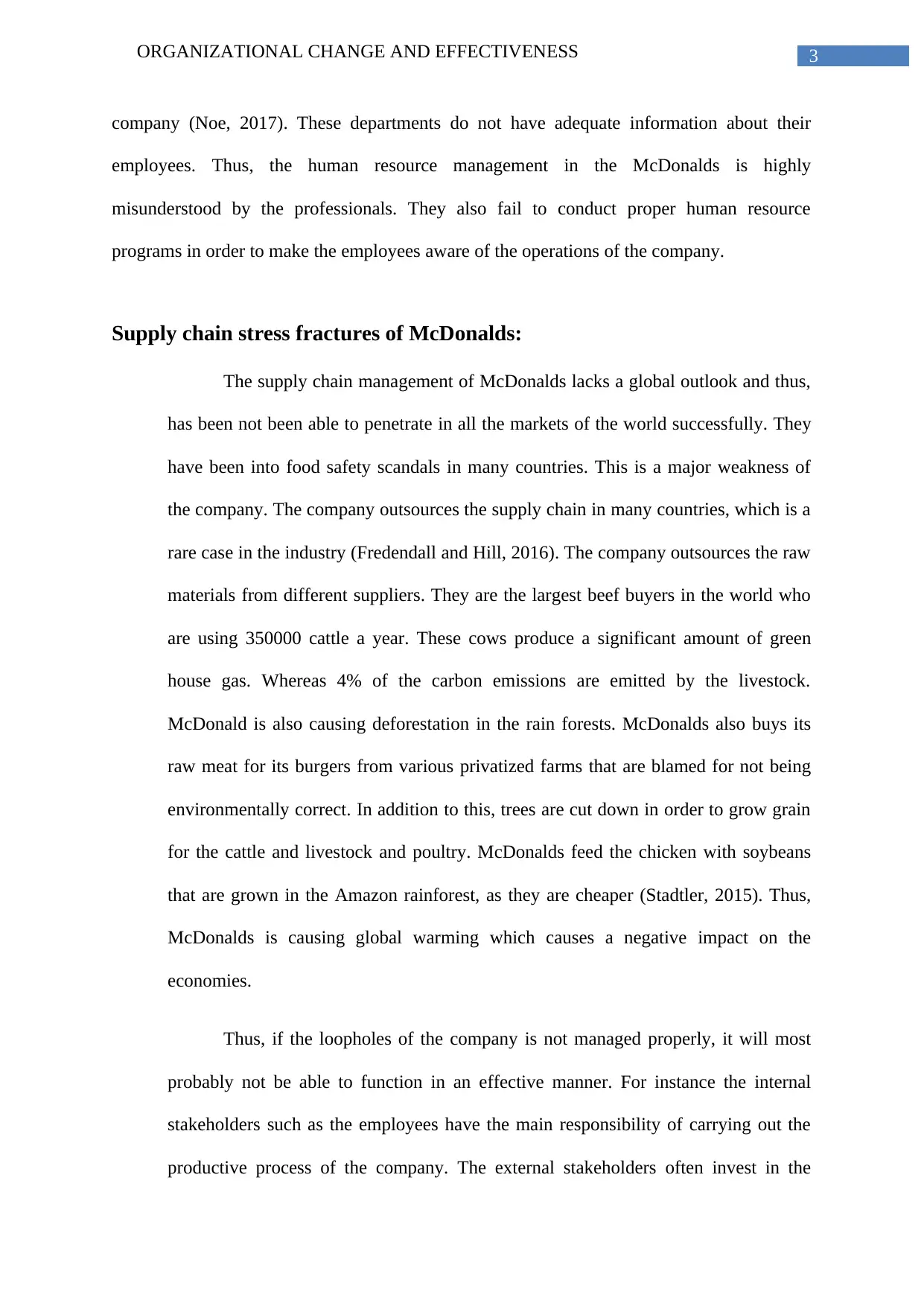
3ORGANIZATIONAL CHANGE AND EFFECTIVENESS
company (Noe, 2017). These departments do not have adequate information about their
employees. Thus, the human resource management in the McDonalds is highly
misunderstood by the professionals. They also fail to conduct proper human resource
programs in order to make the employees aware of the operations of the company.
Supply chain stress fractures of McDonalds:
The supply chain management of McDonalds lacks a global outlook and thus,
has been not been able to penetrate in all the markets of the world successfully. They
have been into food safety scandals in many countries. This is a major weakness of
the company. The company outsources the supply chain in many countries, which is a
rare case in the industry (Fredendall and Hill, 2016). The company outsources the raw
materials from different suppliers. They are the largest beef buyers in the world who
are using 350000 cattle a year. These cows produce a significant amount of green
house gas. Whereas 4% of the carbon emissions are emitted by the livestock.
McDonald is also causing deforestation in the rain forests. McDonalds also buys its
raw meat for its burgers from various privatized farms that are blamed for not being
environmentally correct. In addition to this, trees are cut down in order to grow grain
for the cattle and livestock and poultry. McDonalds feed the chicken with soybeans
that are grown in the Amazon rainforest, as they are cheaper (Stadtler, 2015). Thus,
McDonalds is causing global warming which causes a negative impact on the
economies.
Thus, if the loopholes of the company is not managed properly, it will most
probably not be able to function in an effective manner. For instance the internal
stakeholders such as the employees have the main responsibility of carrying out the
productive process of the company. The external stakeholders often invest in the
company (Noe, 2017). These departments do not have adequate information about their
employees. Thus, the human resource management in the McDonalds is highly
misunderstood by the professionals. They also fail to conduct proper human resource
programs in order to make the employees aware of the operations of the company.
Supply chain stress fractures of McDonalds:
The supply chain management of McDonalds lacks a global outlook and thus,
has been not been able to penetrate in all the markets of the world successfully. They
have been into food safety scandals in many countries. This is a major weakness of
the company. The company outsources the supply chain in many countries, which is a
rare case in the industry (Fredendall and Hill, 2016). The company outsources the raw
materials from different suppliers. They are the largest beef buyers in the world who
are using 350000 cattle a year. These cows produce a significant amount of green
house gas. Whereas 4% of the carbon emissions are emitted by the livestock.
McDonald is also causing deforestation in the rain forests. McDonalds also buys its
raw meat for its burgers from various privatized farms that are blamed for not being
environmentally correct. In addition to this, trees are cut down in order to grow grain
for the cattle and livestock and poultry. McDonalds feed the chicken with soybeans
that are grown in the Amazon rainforest, as they are cheaper (Stadtler, 2015). Thus,
McDonalds is causing global warming which causes a negative impact on the
economies.
Thus, if the loopholes of the company is not managed properly, it will most
probably not be able to function in an effective manner. For instance the internal
stakeholders such as the employees have the main responsibility of carrying out the
productive process of the company. The external stakeholders often invest in the
Paraphrase This Document
Need a fresh take? Get an instant paraphrase of this document with our AI Paraphraser
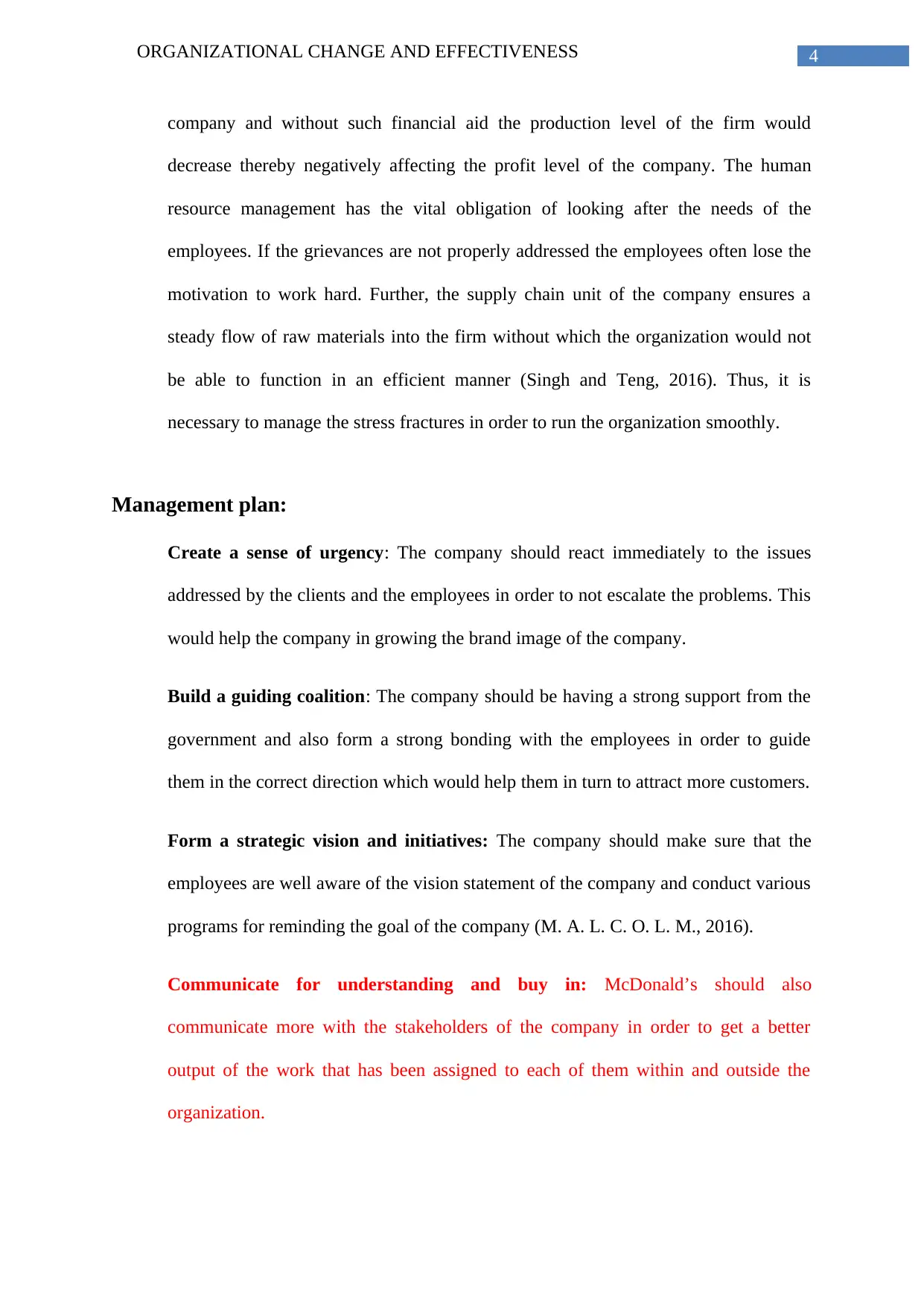
4ORGANIZATIONAL CHANGE AND EFFECTIVENESS
company and without such financial aid the production level of the firm would
decrease thereby negatively affecting the profit level of the company. The human
resource management has the vital obligation of looking after the needs of the
employees. If the grievances are not properly addressed the employees often lose the
motivation to work hard. Further, the supply chain unit of the company ensures a
steady flow of raw materials into the firm without which the organization would not
be able to function in an efficient manner (Singh and Teng, 2016). Thus, it is
necessary to manage the stress fractures in order to run the organization smoothly.
Management plan:
Create a sense of urgency: The company should react immediately to the issues
addressed by the clients and the employees in order to not escalate the problems. This
would help the company in growing the brand image of the company.
Build a guiding coalition: The company should be having a strong support from the
government and also form a strong bonding with the employees in order to guide
them in the correct direction which would help them in turn to attract more customers.
Form a strategic vision and initiatives: The company should make sure that the
employees are well aware of the vision statement of the company and conduct various
programs for reminding the goal of the company (M. A. L. C. O. L. M., 2016).
Communicate for understanding and buy in: McDonald’s should also
communicate more with the stakeholders of the company in order to get a better
output of the work that has been assigned to each of them within and outside the
organization.
company and without such financial aid the production level of the firm would
decrease thereby negatively affecting the profit level of the company. The human
resource management has the vital obligation of looking after the needs of the
employees. If the grievances are not properly addressed the employees often lose the
motivation to work hard. Further, the supply chain unit of the company ensures a
steady flow of raw materials into the firm without which the organization would not
be able to function in an efficient manner (Singh and Teng, 2016). Thus, it is
necessary to manage the stress fractures in order to run the organization smoothly.
Management plan:
Create a sense of urgency: The company should react immediately to the issues
addressed by the clients and the employees in order to not escalate the problems. This
would help the company in growing the brand image of the company.
Build a guiding coalition: The company should be having a strong support from the
government and also form a strong bonding with the employees in order to guide
them in the correct direction which would help them in turn to attract more customers.
Form a strategic vision and initiatives: The company should make sure that the
employees are well aware of the vision statement of the company and conduct various
programs for reminding the goal of the company (M. A. L. C. O. L. M., 2016).
Communicate for understanding and buy in: McDonald’s should also
communicate more with the stakeholders of the company in order to get a better
output of the work that has been assigned to each of them within and outside the
organization.
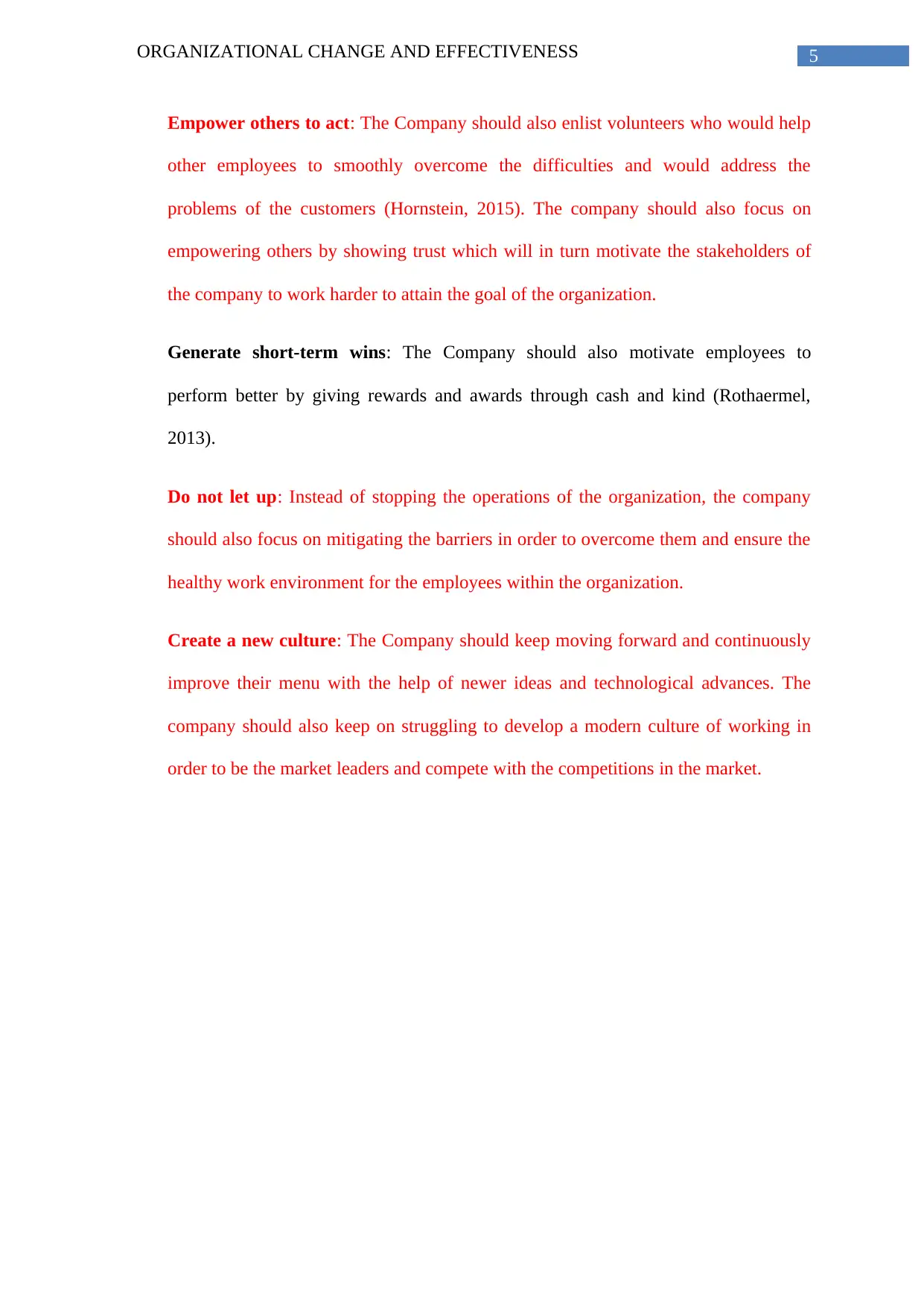
5ORGANIZATIONAL CHANGE AND EFFECTIVENESS
Empower others to act: The Company should also enlist volunteers who would help
other employees to smoothly overcome the difficulties and would address the
problems of the customers (Hornstein, 2015). The company should also focus on
empowering others by showing trust which will in turn motivate the stakeholders of
the company to work harder to attain the goal of the organization.
Generate short-term wins: The Company should also motivate employees to
perform better by giving rewards and awards through cash and kind (Rothaermel,
2013).
Do not let up: Instead of stopping the operations of the organization, the company
should also focus on mitigating the barriers in order to overcome them and ensure the
healthy work environment for the employees within the organization.
Create a new culture: The Company should keep moving forward and continuously
improve their menu with the help of newer ideas and technological advances. The
company should also keep on struggling to develop a modern culture of working in
order to be the market leaders and compete with the competitions in the market.
Empower others to act: The Company should also enlist volunteers who would help
other employees to smoothly overcome the difficulties and would address the
problems of the customers (Hornstein, 2015). The company should also focus on
empowering others by showing trust which will in turn motivate the stakeholders of
the company to work harder to attain the goal of the organization.
Generate short-term wins: The Company should also motivate employees to
perform better by giving rewards and awards through cash and kind (Rothaermel,
2013).
Do not let up: Instead of stopping the operations of the organization, the company
should also focus on mitigating the barriers in order to overcome them and ensure the
healthy work environment for the employees within the organization.
Create a new culture: The Company should keep moving forward and continuously
improve their menu with the help of newer ideas and technological advances. The
company should also keep on struggling to develop a modern culture of working in
order to be the market leaders and compete with the competitions in the market.
⊘ This is a preview!⊘
Do you want full access?
Subscribe today to unlock all pages.

Trusted by 1+ million students worldwide

6ORGANIZATIONAL CHANGE AND EFFECTIVENESS
References
Fredendall, L.D. and Hill, E., 2016. Basics of supply chain management. CRC Press.
Hornstein, H. A. (2015). The integration of project management and organizational change
management is now a necessity. International Journal of Project Management, 33(2), 291-
298.
McDONALD, M. A. L. C. O. L. M. (2016). Strategic marketing planning: theory and practice.
In The marketing book (pp. 108-142). Routledge.
Noe, R. A., Hollenbeck, J. R., Gerhart, B., & Wright, P. M. (2017). Human resource management:
Gaining a competitive advantage. New York, NY: McGraw-Hill Education.
Rothaermel, F. T. (2013). Strategic management: concepts. New York, NY: McGraw-Hill Irwin.
Simon, S. J., & Grover, V. (1993). Strategic use of information technology in international business:
A framework for information technology application. Journal of Global Information
Management (JGIM), 1(2), 21-32.
Singh, A. and Teng, J.T., 2016. Enhancing supply chain outcomes through Information Technology
and Trust. Computers in human behavior, 54, pp.290-300.
Stadtler, H., 2015. Supply chain management: An overview. In Supply chain management and
advanced planning (pp. 3-28). Springer, Berlin, Heidelberg.
Stevens, G.C. and Johnson, M., 2016. Integrating the supply chain… 25 years on. International
Journal of Physical Distribution & Logistics Management, 46(1), pp.19-42.
References
Fredendall, L.D. and Hill, E., 2016. Basics of supply chain management. CRC Press.
Hornstein, H. A. (2015). The integration of project management and organizational change
management is now a necessity. International Journal of Project Management, 33(2), 291-
298.
McDONALD, M. A. L. C. O. L. M. (2016). Strategic marketing planning: theory and practice.
In The marketing book (pp. 108-142). Routledge.
Noe, R. A., Hollenbeck, J. R., Gerhart, B., & Wright, P. M. (2017). Human resource management:
Gaining a competitive advantage. New York, NY: McGraw-Hill Education.
Rothaermel, F. T. (2013). Strategic management: concepts. New York, NY: McGraw-Hill Irwin.
Simon, S. J., & Grover, V. (1993). Strategic use of information technology in international business:
A framework for information technology application. Journal of Global Information
Management (JGIM), 1(2), 21-32.
Singh, A. and Teng, J.T., 2016. Enhancing supply chain outcomes through Information Technology
and Trust. Computers in human behavior, 54, pp.290-300.
Stadtler, H., 2015. Supply chain management: An overview. In Supply chain management and
advanced planning (pp. 3-28). Springer, Berlin, Heidelberg.
Stevens, G.C. and Johnson, M., 2016. Integrating the supply chain… 25 years on. International
Journal of Physical Distribution & Logistics Management, 46(1), pp.19-42.
Paraphrase This Document
Need a fresh take? Get an instant paraphrase of this document with our AI Paraphraser

7ORGANIZATIONAL CHANGE AND EFFECTIVENESS
1 out of 8
Related Documents
Your All-in-One AI-Powered Toolkit for Academic Success.
+13062052269
info@desklib.com
Available 24*7 on WhatsApp / Email
![[object Object]](/_next/static/media/star-bottom.7253800d.svg)
Unlock your academic potential
Copyright © 2020–2025 A2Z Services. All Rights Reserved. Developed and managed by ZUCOL.





